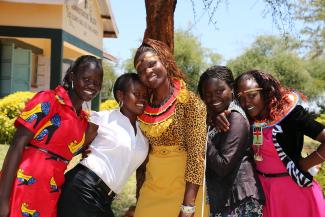By USAID Kenya and East Africa Mission Director Mark Meassick
Today is International Day of the Girl Child during the year of the 25th anniversary of the World Conference on Women in Beijing. A wise woman once told me that “show me the state of the adolescent girl in your country, and that will tell me what the state of your country really is.” I have found that to be true.
I wish the data showed that the UN rights of the child for girls born since those global agreements were signed was exponentially better than other generations. But the statistics on the girl child in Kenya are startling and worrisome. The widespread neglect and abuse young girls are suffering from a very tender age needs to change. Data demonstrates that investments in the well-being of girls are a key driver to transform societies and to accelerate prosperity. Nations that marginalize and subordinate young girls are less competitive and more violent.
Adolescent girls face risks related to their reproductive health long before they should have to. Data show that one in five girls (22.3%) are pregnant before the age of 18. The data show that among females who experienced childhood sexual violence, more than three out of five (62.6%) experienced multiple incidents before age 18. Adolescent girls in Kenya are also disproportionately affected by the HIV epidemic, accounting for two thirds of new infections.
A just-concluded National Crime Research Centre study shows that the number of cases of gender-based violence, girl-child disempowerment, and violations of children’s rights was getting worse before reaching a soaring crisis during COVID-19. The escalation is projected to increase in the COVID-19 altered context and uncertainties. GBV cases increased 92% between January to June 2020, compared to January to December 2019. Data show that 71.0% of the cases (1,716 cases) of GBV reported between January and June 2020 were female victims, which is equivalent to 10 females daily being treated badly because she is female.
Early child-bearing disrupts a girl’s schooling and most never get a second chance to go back. It also affects the long-term health of both her and her baby. 21% of Kenyan women and girls have undergone female genital mutliation (FGM). Narok County, home to Kenya’s cherished Maasai Mara, reports incredibly high incidents of FGM at 78% which is accompanied by other forms of gender-based violence. Women in pastoral communities own less than 1% of the land and are excluded from ownership on cultural grounds. These conditions startle international tourists and cast a shadow over the tourism experience that Kenya needs to be competitive and expand.
At times girls are disadvantaged just because of the natural process of menstruation. For instance, girls from poor families miss 20% of school days in a year due to lack of sanitary towels, which is equivalent to almost 24 weeks out of 144 weeks of missed learning due to her period. 65% of girls in Kenya cannot regularly access sanitary pads to manage their periods.
These are statistics of the poorest countries in the world, and should not still be this prevalent in a middle income country. The Kenyan girl should not have to face these multiple risks just because she is born female. Her future aspirations and her vision for her god-given life should be just as important as the financial value that her labor and reproductive potential provide to her parents.
The statistic of 23% of Kenyan girls are married before their 18th birthday with 4% being married before the age of 15. A significant number of these child brides are being married to men much older. Many girls are still subject to FGM. Others are constantly objectified from ages as early as 8 years old due to traditions that today can only be characterized as expressions of toxic masculinity. This clash of culture and Kenyan law rooted in treaties that allow Kenya to be a part of the family of nations needs to start putting the future of Kenyan girls first. The voices of girls need to come out of the shadows, out of the fields, out of the oppressive toxicity of patriarchal traditions.
On this International Day of the Girl let us pause. As fathers, as mothers, as grandparents, as aunts and uncles let us see the innocence in the eyes of our daughters, our nieces, our grand-daughters. Let us appreciate their dreams, their aspirations and protect the rights they should enjoy to pursue them. Parents, elders, teachers and medical professionals the time for change is now. Kenya’s adolescent girls are the best hope for a brighter future for Kenya. Let us teach our sons, our grandsons, our husbands and fathers to respect their girls with the same respect and dignity they also deserve.
USAID believes that it is critical to expand public attention, government programs, and private sector investment to work with families and communities and better support adolescent girls and the people involved in shaping her life. Our new strategy will seek to build new kinds of partnerships that enable Kenyans to create a safe, nourishing and loving environment for all Kenya’s young girls to pursue their dreams and fulfill their potential as one of God’s children.
For more information contact
Senior Development Outreach and Communications Advisor Kim Case
E-mail: kcase@usaid.gov
Mobile: 0706 033 203

Irene Angwenyi/USAID
